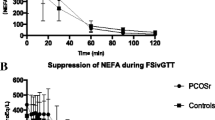Abstract
Classic galactosemia (CG) is an inherited metabolic disorder that affects about 1 in 50,000 live births in the United States and many other countries. With the benefit of early detection by newborn screening and rapid dietary restriction of galactose, generally achieved by removing dairy from the diet, most affected infants are spared the acute and potentially lethal symptoms of disease. Despite early detection and life-long dietary intervention, however, most patients grow to experience a constellation of long-term complications that include premature ovarian insufficiency in the vast majority of girls and young women. Our goal in the study reported here was to define the presentation, progression, and predictors of ovarian insufficiency in a cohort of 102 post-pubertal girls and women with CG. To our knowledge, this is the largest cohort studied to date. We found that 68% of the girls and women in our study achieved spontaneous menarche, while 32% achieved menarche only after starting hormone replacement therapy (HRT). Of those who achieved spontaneous menarche, fewer than 50% were still cycling regularly after 3 years, and fewer than 15% were still cycling regularly after 10 years. Of factors tested for possible association with spontaneous menarche, only detectable (≥ 0.04 ng/mL) plasma anti-Müllerian hormone (AMH) level was significant. These results extend substantially from prior studies and confirm that detectable plasma AMH is a useful predictor of ovarian function in girls and women with CG.




Similar content being viewed by others
References
Berry G (2014) Classic galactosemia and clinical variant galactosemia. In: Adam MP, Ardinger HH, Pagon RA, Wallace SE, Bean LJH, Stephens K, Amemiya A (eds) GeneReviews® [Internet]. Seattle (WA): University of Washington, Seattle; 1993–2018
Frederick AB, Cutler DJ, Fridovich-Keil JL (2017) Rigor of non-dairy galactose restriction in early childhood, measured by retrospective survey, does not associate with severity of five long-term outcomes quantified in 231 children and adults with classic galactosemia. J Inherit Metab Dis 40:813–821
Fridovich-Keil JL, Gubbels CS, Spencer JB, Sanders RD, Land JA, Rubio-Gozalbo E (2011) Ovarian function in girls and women with GALT-deficiency galactosemia. J Inherit Metab Dis 34:357–366
Hagen CP, Aksglaede L, Sørensen K et al (2010) Serum levels of anti-Müllerian hormone as a marker of ovarian function in 926 healthy females from birth to adulthood and in 172 Turner syndrome patients. J Clin Endocrinol Metab 95:5003–5010
Hansen KR, Hodnett GM, Knowlton N, Craig LB (2011) Correlation of ovarian reserve tests with histologically determined primordial follicle number. Fertil Steril 95:170–175
Kaufman FR, Kogut MD, Donnell GN, Goebelsmann U, March C, Koch R (1981) Hypergonadotropic hypogonadism in female patients with galactosemia. N Engl J Med 304:994–998
La Marca A, Volpe A (2006) Anti-Müllerian hormone (AMH) in female reproduction: is measurement of circulating AMH a useful tool? Clin Endocrinol (Oxf) 64:603–610
La Marca A, Sighinolfi G, Radi D et al (2010) Anti-Mullerian hormone (AMH) as a predictive marker in assisted reproductive technology (ART). Hum Reprod Update 16:113–130
La Marca A, Grisendi V, Griesinger G (2013) How much does AMH really vary in normal women? Int J Endocrinol 2013:959487
Lindhardt Johansen M, Hagen CP, Johannsen TH et al (2013) Anti-Müllerian hormone and its clinical use in pediatrics with special emphasis on disorders of sex development. Int J Endocrinol 2013:198698
Riehman K, Crews C, Fridovich-Keil JL (2001) Relationship between genotype, activity, and galactose sensitivity in yeast expressing patient alleles of human galactose-1-phosphate uridylyltransferase. J Biol Chem 276:10634–10640
Sanders RD, Spencer JB, Epstein MP et al (2009) Biomarkers of ovarian function in girls and women with classic galactosemia. Fertil Steril 92:344–351
Schweitzer S, Shin Y, Jakobs C, Brodehl J (1993) Long-term outcome in 134 patients with galactosaemia. Eur J Pediatr 152:36–43
Spencer JB, Badik JR, Ryan EL et al (2013) Modifiers of ovarian function in girls and women with classic galactosemia. J Clin Endocrinol Metab 98:E1257–E1265
Sullivan SD, Sarrel PM, Nelson LM (2016) Hormone replacement therapy in young women with primary ovarian insufficiency and early menopause. Fertil Steril 106:1588–1599
Thakur M, Feldman G, Puscheck EE (2018) Primary ovarian insufficiency in classic galactosemia: current understanding and future research opportunities. J Assist Reprod Genet 35:3–16
van Erven B, Berry GT, Cassiman D et al (2017) Fertility in adult women with classic galactosemia and primary ovarian insufficiency. Fertil Steril 108:168–174
Waggoner DD, Buist NR, Donnell GN (1990) Long-term prognosis in galactosaemia: results of a survey of 350 cases. J Inherit Metab Dis 13:802–818
Welling L, Bernstein LE, Berry GT et al (2017) International clinical guideline for the management of classical galactosemia: diagnosis, treatment, and follow-up. J Inherit Metab Dis 40:171–176
Acknowledgements
We are especially grateful to the many families and individuals who participated in this study, and to the Galactosemia Foundation (http://www.galactosemia.org), through which most volunteers found us. Without them, none of this work would have been possible. This work was funded in part by grant DK107900 from the National Institutes of Health (to JLF-K).
Funding
This work was funded in part by NIH grant DK107900 (to JLF-K). The authors confirm independence from the sponsors; the content of this article was not influenced by the sponsors.
Author information
Authors and Affiliations
Corresponding author
Ethics declarations
Conflict of interest
A. Frederick, A. Zinsli, G. Carlock, K. Conneely, J. Fridovich-Keil all declare that they have no conflict of interest.
Animal rights (IACUC)
This article does not contain any studies with animal subjects performed by the any of the authors.
Additional information
Communicated by: Ina Knerr
Electronic supplementary material
Below is the link to the electronic supplementary material.
ESM 1
(DOCX 27 kb)
Rights and permissions
About this article
Cite this article
Frederick, A.B., Zinsli, A.M., Carlock, G. et al. Presentation, progression, and predictors of ovarian insufficiency in classic galactosemia. J Inherit Metab Dis 41, 785–790 (2018). https://doi.org/10.1007/s10545-018-0177-0
Received:
Revised:
Accepted:
Published:
Issue Date:
DOI: https://doi.org/10.1007/s10545-018-0177-0




